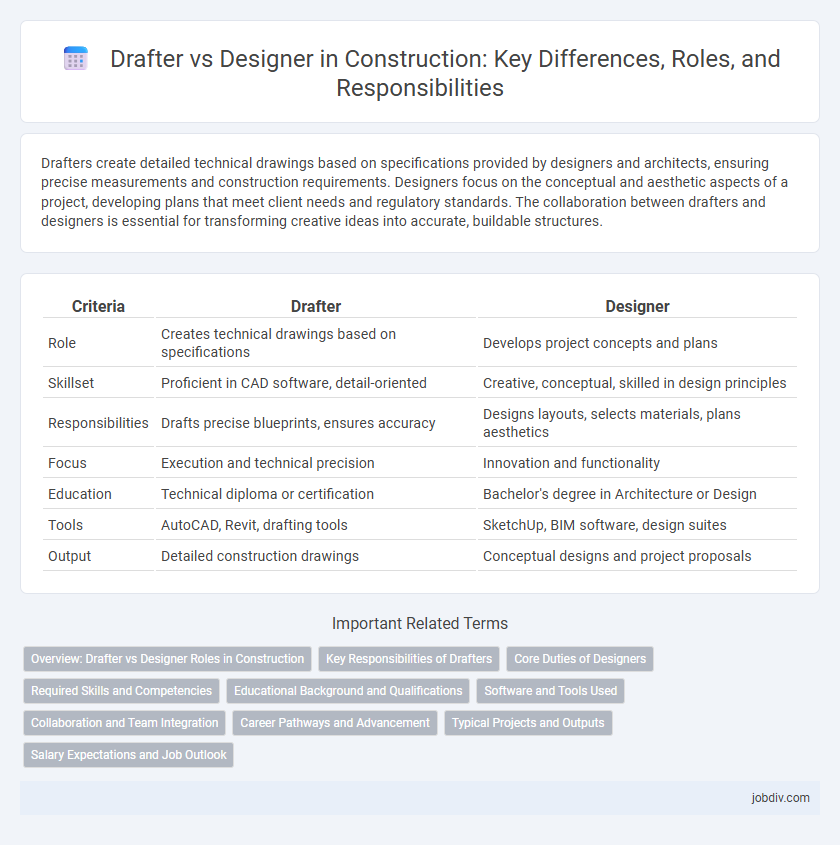Drafters create detailed technical drawings based on specifications provided by designers and architects, ensuring precise measurements and construction requirements. Designers focus on the conceptual and aesthetic aspects of a project, developing plans that meet client needs and regulatory standards. The collaboration between drafters and designers is essential for transforming creative ideas into accurate, buildable structures.
Table of Comparison
| Criteria | Drafter | Designer |
|---|---|---|
| Role | Creates technical drawings based on specifications | Develops project concepts and plans |
| Skillset | Proficient in CAD software, detail-oriented | Creative, conceptual, skilled in design principles |
| Responsibilities | Drafts precise blueprints, ensures accuracy | Designs layouts, selects materials, plans aesthetics |
| Focus | Execution and technical precision | Innovation and functionality |
| Education | Technical diploma or certification | Bachelor's degree in Architecture or Design |
| Tools | AutoCAD, Revit, drafting tools | SketchUp, BIM software, design suites |
| Output | Detailed construction drawings | Conceptual designs and project proposals |
Overview: Drafter vs Designer Roles in Construction
Drafters in construction specialize in creating detailed technical drawings and blueprints based on designers' concepts, ensuring precise specifications for builders. Designers focus on conceptualizing and planning structures, integrating functionality, aesthetics, and compliance with building codes. Both roles are essential, with drafters translating designers' ideas into executable plans that guide construction projects.
Key Responsibilities of Drafters
Drafters primarily create detailed technical drawings based on architects' or engineers' specifications, using computer-aided design (CAD) software to ensure precision and compliance with building codes. They transform conceptual sketches into detailed plans that guide construction teams during material selection, measurement, and assembly. Their key responsibilities include revising drawings to incorporate changes, coordinating with designers and engineers to resolve discrepancies, and maintaining documentation for project approvals and inspections.
Core Duties of Designers
Designers in construction focus on creating detailed architectural plans and specifications that ensure structural integrity and aesthetic appeal. They collaborate with engineers and clients to develop functional layouts, select materials, and comply with building codes. Their core duties include conceptualizing project designs, preparing technical drawings using CAD software, and overseeing the integration of design elements throughout the construction process.
Required Skills and Competencies
Drafters excel in technical drawing skills, proficiency with CAD software, and detailed knowledge of construction standards to create accurate blueprints. Designers require strong creativity, spatial awareness, and an understanding of architectural principles to conceptualize functional and aesthetically pleasing structures. Both roles demand solid communication skills and collaboration to ensure design feasibility and compliance with project specifications.
Educational Background and Qualifications
Drafters typically hold an associate degree or certificate in drafting, emphasizing proficiency in computer-aided design (CAD) software and technical drawing. Designers often possess a bachelor's degree in architecture, engineering, or industrial design, with comprehensive knowledge of design theory, materials, and project management. Certification such as CAD certification for drafters and professional licensure (e.g., Architect Registration Examination) for designers further distinguishes their qualifications in construction projects.
Software and Tools Used
Drafters primarily use CAD software such as AutoCAD and Revit to create precise technical drawings and blueprints for construction projects. Designers often employ advanced 3D modeling tools like SketchUp, Rhino, or BIM software to develop conceptual and detailed building designs. Both roles utilize project management platforms like Navisworks or BIM 360 to enhance collaboration and streamline workflow in construction planning.
Collaboration and Team Integration
Drafters and designers collaborate closely in construction projects, combining technical precision and creative vision to produce detailed blueprints and innovative plans. Effective team integration ensures seamless communication between drafters who translate design concepts into accurate drawings and designers who develop project aesthetics and functionality. This synergy enhances project accuracy, reduces errors, and accelerates the construction timeline.
Career Pathways and Advancement
Drafters typically begin with technical training in CAD software, advancing through experience to senior drafting or specialized roles in construction documentation. Designers often pursue formal education in architecture or engineering, progressing toward project management, creative direction, or consultancy within construction firms. Career advancement for both roles depends on skill development, portfolio quality, and industry certifications, with designers generally having broader opportunities in strategic planning and innovation.
Typical Projects and Outputs
Drafters typically produce detailed technical drawings and blueprints essential for construction projects such as residential buildings, bridges, and infrastructure. Designers focus on conceptual plans and 3D models for architectural, interior, and landscape projects, guiding the overall aesthetic and functional aspects. Outputs from drafters include precise CAD drawings and specifications, while designers deliver creative layouts and visual presentations.
Salary Expectations and Job Outlook
Drafters typically earn a median annual salary of around $57,000, while designers in construction command higher salaries averaging $70,000 to $85,000 due to advanced responsibilities. The job outlook for drafters shows a slight decline or minimal growth as automation tools improve efficiency, whereas designers enjoy robust growth projected at 5-10% annually, driven by increased demand for innovative building solutions. Career advancement for designers often involves specialization and project leadership roles, making their prospects more favorable compared to drafters.
Drafter vs Designer Infographic

 jobdiv.com
jobdiv.com